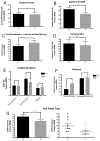Discrete change in volatile anesthetic sensitivity in mice with inactivated tandem pore potassium ion channel TRESK
- PMID: 21042202
- PMCID: PMC3010361
- DOI: 10.1097/ALN.0b013e3181f90ca5
Discrete change in volatile anesthetic sensitivity in mice with inactivated tandem pore potassium ion channel TRESK
Abstract
Background: We investigated the role of tandem pore potassium ion channel (K2P) TRESK in neurobehavioral function and volatile anesthetic sensitivity in genetically modified mice.
Methods: Exon III of the mouse TRESK gene locus was deleted by homologous recombination using a targeting vector. The genotype of bred mice (wild type, knockout, or heterozygote) was determined using polymerase chain reaction. Morphologic and behavioral evaluations of TRESK knockout mice were compared with wild-type littermates. Sensitivity of bred mice to isoflurane, halothane, sevoflurane, and desflurane were studied by determining the minimum alveolar concentration preventing movement to tail clamping in 50% of each genotype.
Results: With the exception of decreased number of inactive periods and increased thermal pain sensitivity (20% decrease in latency with hot plate test), TRESK knockout mice had healthy development and behavior. TRESK knockout mice showed a statistically significant 8% increase in isoflurane minimum alveolar concentration compared with wild-type littermates. Sensitivity to other volatile anesthetics was not significantly different. Spontaneous mortality of TRESK knockout mice after initial anesthesia testing was nearly threefold higher than that of wild-type littermates.
Conclusions: TRESK alone is not critical for baseline central nervous system function but may contribute to the action of volatile anesthetics. The inhomogeneous change in anesthetic sensitivity corroborates findings in other K2P knockout mice and supports the theory that the mechanism of volatile anesthetic action involves multiple targets. Although it was not shown in this study, a compensatory effect by other K2P channels may also contribute to these observations.
Figures
Similar articles
-
Knockout of the gene encoding the K(2P) channel KCNK7 does not alter volatile anesthetic sensitivity.Behav Brain Res. 2008 Nov 21;193(2):192-6. doi: 10.1016/j.bbr.2008.05.010. Epub 2008 May 20. Behav Brain Res. 2008. PMID: 18572259 Free PMC article.
-
Potent activation of the human tandem pore domain K channel TRESK with clinical concentrations of volatile anesthetics.Anesth Analg. 2004 Dec;99(6):1715-1722. doi: 10.1213/01.ANE.0000136849.07384.44. Anesth Analg. 2004. PMID: 15562060
-
Species-specific differences in response to anesthetics and other modulators by the K2P channel TRESK.Anesth Analg. 2005 Oct;101(4):1042-1049. doi: 10.1213/01.ane.0000168447.87557.5a. Anesth Analg. 2005. PMID: 16192517
-
Tandem pore domain K channels: an important site of volatile anesthetic action?Curr Drug Targets. 2000 Sep;1(2):207-17. doi: 10.2174/1389450003349335. Curr Drug Targets. 2000. PMID: 11465071 Review.
-
Roles of TRESK, a novel two-pore domain K+ channel, in pain pathway and general anesthesia.Neurosci Bull. 2008 Jun;24(3):166-72. doi: 10.1007/s12264-008-0225-0. Neurosci Bull. 2008. PMID: 18500390 Free PMC article. Review.
Cited by
-
New directions in migraine.BMC Med. 2011 Oct 25;9:116. doi: 10.1186/1741-7015-9-116. BMC Med. 2011. PMID: 22027350 Free PMC article. Review.
-
The family of K2P channels: salient structural and functional properties.J Physiol. 2015 Jun 15;593(12):2587-603. doi: 10.1113/jphysiol.2014.287268. Epub 2015 Jan 22. J Physiol. 2015. PMID: 25530075 Free PMC article. Review.
-
Advances in genetics of migraine.J Headache Pain. 2019 Jun 21;20(1):72. doi: 10.1186/s10194-019-1017-9. J Headache Pain. 2019. PMID: 31226929 Free PMC article. Review.
-
Determination of minimum alveolar concentration for isoflurane and sevoflurane in a rodent model of human metabolic syndrome.Anesth Analg. 2012 Feb;114(2):297-302. doi: 10.1213/ANE.0b013e31823ede22. Epub 2011 Dec 13. Anesth Analg. 2012. PMID: 22167771 Free PMC article.
-
PKC-dependent activation of human K(2P) 18.1 K(+) channels.Br J Pharmacol. 2012 May;166(2):764-73. doi: 10.1111/j.1476-5381.2011.01813.x. Br J Pharmacol. 2012. PMID: 22168364 Free PMC article.
References
-
- Goldstein SA, Bockenhauer D, O’Kelly I, Zilberberg N. Potassium leak channels and the KCNK family of two-P-domain subunits. Nat Rev Neurosci. 2001;2:175–84. - PubMed
-
- Ketchum KA, Joiner WJ, Sellers AJ, Kaczmarek LK, Goldstein SA. A new family of outwardly rectifying potassium channel proteins with two pore domains in tandem. Nature. 1995;376:690–5. - PubMed
Publication types
MeSH terms
Substances
Grants and funding
LinkOut - more resources
Full Text Sources
Molecular Biology Databases






